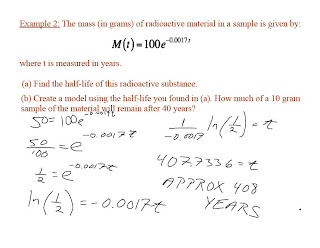Class started off with looking at a question that we did yesterday. After that we saw a clip of a Star Trek episode called The Trouble With Tribbles. If you want to watch it there is a video link on slide 3. After we watched it we wrote down The calculations that Spock had said. We then decided to check if the calculations that Spock said were correct.

After making an equation we then concluded that Spock had lied.
We then decided to ponder was Spock really wrong?? or did he just round it to 3 days.
On Slide 5, 6, and 7 are all calculations to check if Spock was right. There are also many different ways on how to solve logarithms. on slide 6 Paul used time in days not hours with log. Joyce used time in hours not days with logs. And Roxanne used time in hours not days with Ln. As you can see All the answers are the same. with exceptions to rounding.
Here is a reminder to everybody make sure to round to four decimal places if answer is not specified to any digit. Also make sure not to use slashes in your division because it might lead to errors.

On slide 8 is just a modification on how to make your work look more eloquent. And also to tell everyone that Spock never lied. He is smart and has no emotions.
On Slide 9 the value of t was wrong. On the same slide we debated on what the was could be.?? would it be base 100e ^-0.0017t or was it one hundred times base e^ -0.0017t. After a really really long debate we concluded that it was just one hundred times base e^ -0.0017t.

Now on Slide 10 we then found the correct answer. If you are wondering on how to do this question here is how. The first thing you do is right down the equation. The next step would be to divide both sides buy one hundred. The Next step would be to take the ln of both side because its already at base e. The fourth step would be to divide both sides by -0.0017 . And finally the last step would be to solve for t by putting the equation correctly in your calculator.

On slide 11 we then got rearrange in to groups and started to solve for question b of example 2.
To solve this question you needed to use a new formula that we created. Which is the bottom formula of slide 11. Or the slide above us.

Now the 12 and final slide of the day. On this slide we were given a question that had to do with Canada's population.
We were given information and for question (a) we had to write an equation that represents the population of Winnipeg. One problem that people had including myself was that 0.54 % is not 0.54 it is actually 0.0054. Another problem is that you need to add one to the rate or else it wont take into affect the other previous times. and also if you don't add one it will be a negative value.
Now for (b) you needed to make P(y) to double of 630700 which is 1261400 and then solve for y in the exponent. The first step to do is to divide both sides by 630700 so that your left with 2 = 1.0054^y after that you could take the log or the ln of both sides. (The one that i would pick would be ln because it is one less letter then log.) the next step is to rearrange the question to solve for y. After that is done you could then just plug in the values into your calculator and your done.
Well now that the scribe is done time to pick a new scribe. The scribe is going to be Roxanne.

No comments:
Post a Comment